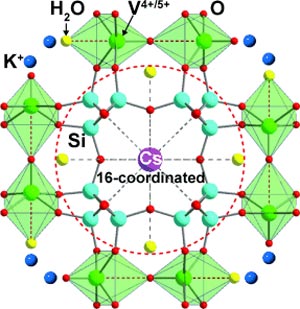Effective Cesium Radioisotope Removal

The Fukushima reactor disaster has been the most recent incident to introduce the public to the concept of “cesium 137”. In the journal Angewandte Chemie, Korean researchers have now introduced a new vanadosilicate that can remove cesium from contaminated coolant water, liquid nuclear waste, and contaminated ground- and seawater more effectively than conventional sorbents.
Cs-137 is among the most dangerous radioactive nuclides. It has a half-life of 30 years, so contaminated areas remain polluted for a long time. The high solubility of cesium salts in water facilitates its dispersal in the environment and its uptake by plants. If humans ingest this contaminated food, the body cannot differentiate the cesium from potassium, so the toxin is stored in muscle tissue. Larger amounts can cause severe radiation sickness; smaller amounts can cause diseases like cancer.
The removal of Cs-137 from contaminated ground- and seawater, as well as liquid nuclear waste from reprocessing and nuclear energy plants is correspondingly critical for public health. The problem is the very high relative concentrations of competing cations like sodium, calcium, magnesium, and potassium ions—which make necessary a highly effective and selective cesium trap. A wide variety of inorganic materials have been developed, although there has been no substantial progress in the last 20 years. To date, titanosilicates have worked best, and these were put into use after the Fukushima reactor disaster.
Kyung Byung Yoon and a team from Sogang University in Seoul, South Korea have now developed a new material named as “Sogang University-45” (or SGU-45 for short) that very effectively binds and immobilizes cesium from groundwater, seawater, and liquid nuclear waste. Under the test conditions used, in concentrations of 10 ppb to 100 ppm, SGU-45 was shown to be superior to all previous materials with regard to selectivity, capacity, and rate of absorption. Strikingly, unlike other materials, the selectivity of K-SGU-4, the variant loaded with potassium ions, to cesium increases as the cesium concentration decreases.
SGU-45 is a special, microporous vanadosilicate with vanadium ions in the 4+ and 5+ oxidation states. K-SGU-45 was best suited for the removal of cesium from contaminated groundwater and seawater, as well as strongly acidic or basic nuclear waste. The cesium ions absorbed replace the potassium ions in K-SGU-45. The framework of SGU-45 already carries non-exchangeable cesium ions which are 16-coordinate, meaning that they have 16 neighboring atoms bonded to cesium. This observation is of academic interest because this is the highest coordination number (the number of nearest neighbors in a crystal lattice or complex) yet observed in chemistry.
About the Author
Dr. Kyung Byung Yoon is Professor of Chemistry at Sogang University, Seoul, Korea. He is also the Director of the Korea Center for Artificial Photosynthesis. He has been working in the area of zeolite research for the last 30 years. He is the recipient of the Korea Science Award and the Academic Award from the National Academy of Science, Korea.
Author: Kyung Byung Yoon, Sogang University, Seoul (Rep. Korea), http://hompi.sogang.ac.kr/zeolite/eyoon.htm
Title: A Novel Vanadosilicate with Hexadeca-Coordinated Cs+ Ions as a Highly Effective Cs+ Remover
Angewandte Chemie International Edition, Permalink to the article: http://dx.doi.org/10.1002/anie.201402778
Media Contact
All latest news from the category: Life Sciences and Chemistry
Articles and reports from the Life Sciences and chemistry area deal with applied and basic research into modern biology, chemistry and human medicine.
Valuable information can be found on a range of life sciences fields including bacteriology, biochemistry, bionics, bioinformatics, biophysics, biotechnology, genetics, geobotany, human biology, marine biology, microbiology, molecular biology, cellular biology, zoology, bioinorganic chemistry, microchemistry and environmental chemistry.
Newest articles

NASA: Mystery of life’s handedness deepens
The mystery of why life uses molecules with specific orientations has deepened with a NASA-funded discovery that RNA — a key molecule thought to have potentially held the instructions for…

What are the effects of historic lithium mining on water quality?
Study reveals low levels of common contaminants but high levels of other elements in waters associated with an abandoned lithium mine. Lithium ore and mining waste from a historic lithium…

Quantum-inspired design boosts efficiency of heat-to-electricity conversion
Rice engineers take unconventional route to improving thermophotovoltaic systems. Researchers at Rice University have found a new way to improve a key element of thermophotovoltaic (TPV) systems, which convert heat…



